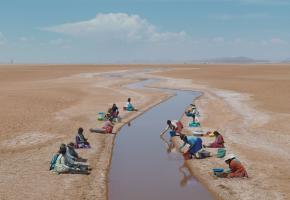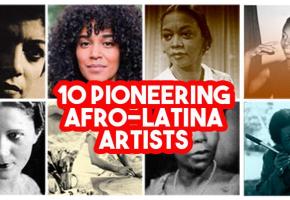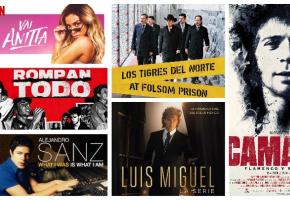Since 1956, Carlos Saura has directed more than 40 films and, astoundingly, has won almost an equal number of awards. His obra is varied, including 'Marathon,' the official film for the Barcelona 1992 Olympics that he was selected to direct, and 'Buñuel and King Salomon's Table' (2001), a homage to his intimate friend, Luis Buñuel. However, today Saura has become known for creating something that makes a selection of his films spanning from the early 80's until now stand out on their own. This 'something' is capturing the arts of dance and music, most prominently flamenco, in his own art of breathtaking visual splendor.
Blood Wedding (Bodas de Sangre), 1981
The first of Saura's flamenco trilogy, this musical received tremendous success. The film revolves around a dance company rehearsing and finally performing Federico García Lorca's 'Blood Wedding.' It is Saura's first collaboration with another huge name in Spanish culture of the time, Antonio Gades, who, with a certain mysticism, leads his dance company through the elemental form of the art of dance. Interruption, repetition, rehearsal clothes and a minimal, bare, windowed space give way to Gades' beautiful choreography, where he and Cristina Hoyos make fascinating principal dancers in this tale of love ruined by the violent, repressive traditions of a culture.
Carmen (1983)
Saura and Antonio Gades collaborate for a second time to make one of the director's most highly-acclaimed and memorable films, which especially attracted international attention. As a dance company works on their interpretation of Bizet's Carmen, the director, Antonio, falls in love with Carmen, the perfect actress for the role with the same name. The enchanting Gades (Antonio) and Laura del Sol (Carmen) unwind the uncomfortable love story, which has the essence and narrative of the unhealthy, consuming relationship of the opera script. Antonio's deliberate disassembling of the cultural myths found in Bizet's work interestingly brings to light how Saura implicitly defines his character as an embodiment of Spanish cultural authenticity.
Love, the Magician (El Amor Brujo), 1986
Completing the trilogy of flamenco films worked on with Antonio Gades, Sauda sets a freely adapted story to Manuel de Falla's incredible music. A collaboration of three of Spain's greatest artist in their fields, the film is also a fusion of another three: death, love and dance. Equally divided into dramatic passages and dance sequences, the flamenco choreography seems to take over the drama, the story being told with eyes and hand gestures more than with words. The tale is concerned with Carmelo (Gades) who is in love with Candela (Cristina Hoyos), who has been arranged to be married with another, under gypsy law. The spiritual fire that the subsequent loves and deaths create are epitomised in the famous 'Ritual Fire Dance' scene.
Sevillanas (1991)
Little known to the world outside Andalusian flamenco, there comes from Seville a dance that is all-too-commonly put under the bracket of flamenco. Saura pays a homage to the dance and song of 'Sevillanas'; its unique art, touching both flamenco and Spanish classical dance, often fully embracing one or the other's spirit, depending on the bailadora or cantadora. Saura provides a beautifully-filmed montage of the most talented Sevillana musicians and dancers of the time, such as Manolo Sanlúcar, Matilde Coral, Pareja Obregón and Paco de Lucía. Each frame is monopolised by the artists and their art, and captures an image of the technique that is as hard to grasp as is a native accent of a second-language, and of the stunning, bright elaborate costume that has remained such a core part of the performance and celebration of this art.
Flamenco (1995)
Here, Saura presents flamenco in documentary rather than narrative form, with the phenomenal result of including practically all the different flamenco styles (such as the up-tempo bulerías, satiric fandangos, menacing farrucas, anguished martinetes, and aristocratic guarijas). The dancers, singers, musicians perform with the purity and honesty that real flamenco entails. With music by Isidro Muñoz and cinematography by Vittorio Storaro, we see families performing some of the sequences and emotions breathing onto the audience (camera and viewer) in fierceness and in festivity.
Salome (Salomé), 2002
A tragedy in Galilea, that occurred more than two thousand years ago, is narrated through dance in Saura's spectacular film. This interpretation of the biblical tale of Salome is minimalist in decor, mythical in atmosphere with ominous lighting and shade. Flamenco is reinterpreted, confronting it with the spirit of some of its oldest origins; the original music (by Roque Baños) has its influences in Arab and Pakistani sources, and Western religious works such as the those of Bach. The wind instruments, Indian percussion and Aída Gómez (Salome and choreographer)'s dancing make an electrifying cinematographic experience.
Iberia (2005)
'Iberia' won the Goya Award in 2006, for Best Photography. It brings together some of Spain's best artists, in combinations like never before of flamenco, classical music, ballet and contemporary dance. The series of dances are inspired by composer Isaac Albéniz's 'Iberia' suite. This intensely dramatic film is another clear celebration of an art-form cherished, this time breaking out of its limits to engage with other magnificent expressions of being.
Flamenco, Flamenco, 2010
The film opens with a rumba; the young Carlos García and Maria Ángeles Fernández singing 'Verde, que te quiero verde,' echoing Lorca's Romance Sonámbulo, which was sung by Ketama to close Flamenco, fourteen years before. Saura exhibits the experience and knowledge gained in that time in this re-entry into the world of flamenco, following the paths newly laid by the current talents of the alive and dynamic art. Throughout the film, the maestros are accompanying the new. The acclaim of young female voice shines through Montse Cortés and Estrella Morente, one with a soleá por bulerías and the other por tangos. Paco de Lucía, one of the great maestros, performs the bulería por soleá ‘Antonia.’ The dance is prominent in our return to Saura's capturing of flamenco; Sara Baras appears in red to dance por alegrías. Fresh talents follow her, with very young Manuel Fernández ‘El Carpeta’ dancing a bulería, promising us something great for the future.



















